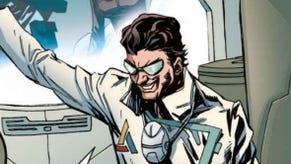Assassin's Creed 3 Remastered on Switch lacks most of the remastering work
But still improves on the last-gen versions.
Assassin's Creed 3 Remastered arrives on Switch after a month's delay, but the question it poses is simple: is this truly a remaster? Based on close comparisons, its visual feature set is more in line with the original last-gen releases - lacking the new rendering features of the PS4, PC and Xbox One versions. Equally problematic is the fact that this release is delivered via a 13.6GB install, down from the 45GB on PS4. Clearly, cuts have been made on Switch - but where? And to what extent does it impact the overall experience?
Let's discuss the positives first. The big surprise is that this game does run at a native 1920x1080 while running docked to a TV. Dynamic resolution can't be fully ruled out, but that's the fixed resolution result I get from every sample. It represents a huge boost over Wii U's native 720p, and brings it up to the level of base PS4 in terms of sheer pixel output. That's not to say it's perfect though: the post anti-aliasing takes away some of the clarity - and it misses dithered elements with lots of sub-pixel detail. Other aspects, like Switch's low-grade ambient occlusion and shadows, introduce shimmer of their own as well. Ultimately, 1080p is a nice plus point, but image quality overall is cut down compared to the other versions.
Also impressive is the portable play. Switch delivers a native 720p here, a pixel-perfect match for the screen, while retaining all of the visual detail and fidelity of the docked experience. Barring a step back in texture filtering quality, and a tweak to the resolution of depth of field, you otherwise get the same game on the go. In common with many Switch games, it's actually better suited for the handheld display, with the smaller screen real estate serving to hide some of the game's blemishes.
In terms of the platform comparisons, stacking up AC3 against the PS4 remaster reveals parity in base resolution, but the differences elsewhere are legion. The other current-gen versions get the more physically-correct materials and lighting interactions, whether that's on faces, clothes or brickwork. Everything's changed. Switch by contrast plays without these upgrades, and even the extra tone-mapping and bloom of the auditorium's lights are missing. You can't help but notice that the higher resolution textures of the other remastered versions also absent, favouring last-gen quality mapping.
Whether or not this is a big deal or not might come down to preference. Not every change made in AC3 Remastered was an aesthetically pleasing one and if you didn't like the remaster's revamped lighting, this might be a perk. There are parts which are clearly a downgrade though; the screen-space ambient occlusion and shadows in general on Switch are very poor. AO especially, is represented by low grade, flickering blobs of shade in corners, and likewise there's a lot of sawtooth edging on background shadows, neither of these are an issue on PlayStation 4.
Next there are the cuts that affect the open world. The AnvilNext engine was designed to stream in large environments seamlessly on last-gen and the challenge was to minimise the appearance of pop-in. Switch inherits the same method as used on PS3 and Xbox 360 - and so, you'll see partially rendered elements in the distance fade in. It's culling giant triangles from plants, objects and buildings until you get close, and creating a distracting dithered effect. It was a necessary compromise on last-gen systems but holding it up to closer scrutiny at 1080p, it does stick out. The game's NPCs are also affected - with both the density and rendering range pruned back on Switch. Combined, it does leave the world looking more barren compared to the other remasters.
One last part that sees some compromise is the inclusion of screen-space reflections. Switch basically reverts to the last-gen style. The water shader gives a great illusion of rippling waves on an ocean body - and while the reflections aren't accurate to the scene, it still looks decent. PS4 does use SSR instead, giving the water a full breadth of reflections based on the camera's view. In practise, the implementation isn't the strongest we've seen. Artefacting is an issue around edges, where you can see a gap between a passing object, and the point at which the reflection kicks in. SSR is a double-edged sword, then - Switch misses out, but the standard reflection tech still looks absolutely fine.
It's easy to see what we've missed, but there is an upside. A comparison with Nintendo's last home console, the Wii U, reveals how much better Switch truly is, with higher-grade shadows up close, and less dithering. Textures are the same across the board and the lighting model is intact - with only a few small tweaks. Factor in the bump to 1080p and it's not a bad deal at all. Curiously, the draw distance on shadows is worse on Switch, but once drawn in they are higher quality on Nintendo's latest hardware. Switch also carries over a few small extras, such as motion controls for aiming weapons, which works surprisingly well.
There are some downsides however. In delivering a 13GB package on Switch, it's not just the textures that take a hit, but also the audio. You get heavily compressed audio from the start, and even the introduction music is unmistakably muffled. Voice quality is pared back, while sound effects are clearly of a lower bitrate than we're used to in other versions. Worse still, the audio channel crackles, too, in transitions to cut-scenes. We've seen Switch games run with lower quality audio before, such as Dark Souls, but this ranks among the more egregious cases.
Glitches are a problem too in this Switch build, notably in NPC animations and oddities on the lighting. A genuine, game-breaking issue even came to light on the game's first mission. During an ambush, the depth of field effect fails to disengage after a cut-scene, making it impossible to see past a few metres. The fix is simply to restart the save - no big deal - but the fact this happened so early on is a concern. My hope is a patch or two are on the way - because as it stands, an extra level of QA is needed to get the level of polish up to scratch.
Performance-wise, Switch delivers a healthy increase in frame-rate compared to the compromised last-gen versions - helped along by adopting the Wii U visual standard. The lighting, SSR, and higher-grade shadows are all reverted back, giving Switch a fighting chance of holding 30fps. In docked play, you can see it's mostly getting there in the opening cut-scene; direct comparison with the Wii U version shows Switch outperforms the last-gen edition. Better still, it does it at 1080p rather than 720p too, with a 5-6fps advantage. The uptick in performance is so extreme, the auditorium sequence even delivers an impressive 10fps leap in performance.
It's far from perfect though. The real sting in the tail is that it still struggles to hold 30fps around open town areas, and you are getting mid-20fps performance at the Boston docks. It is an upgrade though, and likely hangs on the more capable CPU powering the Switch in handling multiple NPCs. It is still in need of improvement of course; even walking around a small tavern on Switch sees frame-rates dropping to the low 20s - and that's with barely any action on-screen.
Interestingly, similar to a great many games, mobile performance at 720p is an improvement over the docked 1080p output, with a 1-2fps advantage when playing portable. It's certainly helped by the lower native res, though Switch is still at the mercy of the same CPU clock speeds in both docked and mobile configurations. The margin may be small, but you are getting a smoother experience in portable play, and the drops are less obvious by virtue of playing on a smaller screen.
Also included in the package is a port of Assassin's Creed 3: Liberation, operating at 900p docked and 720p on the go - both with no anti-aliasing whatsoever. Performance is somewhat odd: playing docked, the frame-rate is entirely unlocked, meaning performance between 20fps and 40fps is the reality - hardly ideal. It's not helped by a lack of a 30fps cap either, though curiously this is at least fixed by playing in handheld mode, where a 30fps cap is suddenly activated, once again making it the preferred way to play the game.
Revisting the AC3 Remaster has proven fascinating, even if the Switch rendition has more in common with its last-gen counterparts. It's the last-gen version at heart, and some of the cutbacks are too glaring for me to recommend it. The compromised sound compression is among the worst I've seen on the system, and numerous glitches and bugs need addressing. There's also some disappointment at the poor shadow work and draw distances, and likewise for the sub-30 frame-rate - but in my view, you can mitigate some of this by playing handheld. This is a much more palatable experience overall - and in that sense, the best thing about this conversion is that there is no portable Assassin's Creed game quite like it. This so-called 'remaster' is still hard to recommend in its current state however - and so here's hoping that Ubisoft can sweep in with a miracle patch to clean up its issues.











